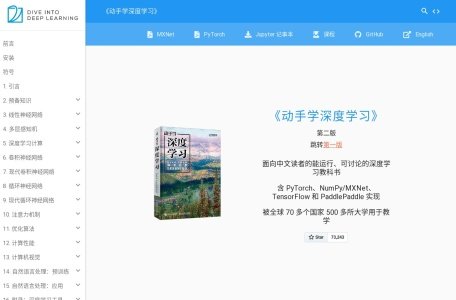
As deep learning transitions from academic circles to industry, countless learners face a dilemma: “understanding theory but not coding, or knowing how to code but lacking grasp of principles.” They shrink from thick math textbooks, yet struggle to build systematic knowledge from scattered online tutorials. However, Dive into Deep Learning, co-authored by AI experts like Mu Li and Aston Zhang, breaks down the “dual barriers” of deep learning education with its unique model of “theory and code advancing hand in hand.” By 2025, the book has accumulated 700,000 readers worldwide, been adopted as a textbook by over 200 universities (including Tsinghua University and Peking University), and become internal training material for companies like ByteDance and Huawei. Drawing on the book’s content, practical cases, and reader feedback, this article unpacks the core logic behind its status as “the No.1 introductory book on deep learning.”
I. Book Positioning: More Than a “Tutorial” – A Complete Deep Learning Practice System
- Academic Rigor: Developed in collaboration with experts from institutions like Stanford University and the University of Michigan, it covers everything from basic mathematics (linear algebra, probability theory) to core algorithms (CNN, RNN, Transformer). Every formula derivation undergoes repeated verification to ensure theoretical depth and cutting-edge relevance;
- Practice-Oriented Approach: The entire book is supplemented with PyTorch code (with TensorFlow implementations in some editions). Each algorithm chapter follows the logic of “principle explanation → code breakdown → result verification,” allowing readers to code while learning and observe the model’s operation in real time;
- Open-Source Accessibility: The book’s electronic version and supporting code are fully free (available on the official d2l.ai website), with both Chinese and English editions to support barrier-free learning for global readers. The Chinese community alone has accumulated over 100,000 reader notes and Q&A entries.
II. Content Structure: A Four-Stage Closed-Loop for Deep Learning Cognition
1. Fundamentals Section: Building the “Foundation” of Deep Learning
- Mathematical Foundations: Using the “housing price prediction” case to explain the mathematical principles of linear regression, and the “image classification” scenario to illustrate gradient descent algorithms. Abstract concepts like vector and matrix operations are transformed into “perceivable problem-solving processes,” making them accessible even to readers with weak calculus backgrounds;
- Tool Introduction: A detailed guide to PyTorch’s core functions (installation, tensor operations, automatic differentiation), paired with a step-by-step example of “building your first neural network.” It breaks down the entire process from “importing libraries → defining the model → training data → evaluating performance,” enabling readers to run their first deep learning program in just 30 minutes;
- Core Concepts: Clear differentiation between easily confused terms (e.g., “machine learning vs. deep learning,” “supervised vs. unsupervised learning,” “overfitting vs. underfitting”). Practical questions like “Why is the ReLU activation function more commonly used than Sigmoid?” guide readers to think about the logic behind technologies.
2. Algorithms Section: Mastering the “Core Technologies” of Deep Learning
- Convolutional Neural Networks (CNNs): Starting with “Why do we need CNNs?” (solving the problem of excessive parameters in fully connected networks), it uses “sliding windows” to analogize convolution operations. Through the “handwritten digit recognition” project (MNIST dataset), readers implement a CNN model, then explore optimization ideas for classic networks like ResNet and Inception;
- Recurrent Neural Networks (RNNs): Using “text generation” as a scenario, it explains the “temporal memory” characteristics of RNNs and compares how LSTMs and GRUs solve the “long-sequence gradient vanishing” problem. The supporting “Tang poetry generation” project allows readers to train models and generate AI-written poems that follow traditional metrics;
- Transformers and Attention Mechanisms: As the “key advanced content” of the book, it uses “focusing on key words in translation” to analogize the attention mechanism, gradually deriving the Transformer’s encoder-decoder structure. Through the “English-Chinese translation” project (IWSLT dataset), readers understand the underlying logic of large models like BERT and GPT.
3. Advanced Section: Addressing “Practical Challenges” in Deep Learning
- Model Optimization Techniques: Covering practical methods like batch normalization, learning rate scheduling, and regularization. Through experiments comparing “model performance with different optimization strategies,” readers visually see “how to make models train faster and perform better”;
- Data Processing Methods: Addressing common issues like “small dataset size” and “poor data quality,” it introduces techniques such as data augmentation (image flipping, text synonym replacement) and transfer learning. The supporting “image classification with small datasets” project demonstrates how transfer learning improves model performance;
- Basic Model Deployment: A brief introduction to deployment-related knowledge (ONNX format conversion, model quantization), with an example of “deploying a trained model to a local computer” to help readers understand “the final step from ‘training a model’ to ‘putting it into use.’”
4. Applications Section: Unlocking “Industry Scenarios” for Deep Learning
- Computer Vision: Covering tasks like image classification, object detection, and image segmentation. Using the “mask detection” project (based on the YOLO model), it breaks down the entire practical process of object detection, from data annotation to model training and result visualization;
- Natural Language Processing: Including applications like text classification, sentiment analysis, and machine translation. The supporting “e-commerce review sentiment analysis” project teaches readers to use BERT models to “automatically identify positive/negative reviews” and generate visualized word cloud analysis results;
- Recommendation Systems: Introducing core technologies like collaborative filtering and matrix factorization. Through the “movie recommendation” project (based on the MovieLens dataset), readers personally implement the function of “recommending personalized movies to different users” and understand key issues like “cold start” in recommendation systems.
III. Core Advantages: Four Traits That Set It Apart from Similar Books
1. “Learn by Doing”: Say Goodbye to “Understanding ≠ Being Able to Apply”
2. Open-Source and Free: Lowering the Barrier to Learning
3. Community Support: A “Mutual-Aid Ecosystem” of 700,000 Readers
- Q&A Support: On the d2l.ai forum or the Zhihu topic “Dive into Deep Learning,” readers typically receive responses to their questions within 12 hours, with some even answered personally by author Mu Li;
- Resource Sharing: Community users voluntarily compile “key chapter notes,” “formula derivation flashcards,” and “project practice videos.” For example, one user’s notes on “line-by-line breakdown of Transformer code” have been downloaded over 50,000 times;
- Study Check-Ins: Regular “30-Day Deep Learning Check-In” events are held, where participants share daily progress and challenges, creating a “mutual motivation” atmosphere. Many readers noted: “Following the community check-ins, I finally persisted in finishing this thick book.”
4. Continuous Iteration: Keeping Pace with Technological Frontiers
IV. Target Audience: Who Should Read This Book?
1. Beginners: A Springboard from “Novice” to “Practitioner”
2. University Students/Instructors: High-Quality “Teaching Materials and Resources”
- For Students: Supporting code and projects reduce “stuck points when doing assignments.” An instructor in a university’s computer science department noted: “Previously, students spent a lot of time debugging code for assignments; with this book, they can focus more on understanding algorithm principles”;
- For Instructors: The official website provides free course PPTs, homework banks, exam outlines, and even “teaching videos” (with Mu Li explaining key chapters), significantly reducing lesson preparation pressure.
3. Industry Professionals: A “Reference Book” for Solving Practical Problems
- When facing model tuning issues, they can refer to the “model optimization chapter” for solutions;
- When taking on projects in new fields (e.g., switching from NLP to recommendation systems), they can quickly grasp core technologies through the “applications section”;
- They can even use the book’s projects as a basis for “technical research.” For example, an algorithm engineer at a company used the “movie recommendation” project as a prototype to build an internal “document recommendation system” in just 2 weeks.
V. Study Guide: Tips for Avoiding Pitfalls and Advancement Paths
1. Efficient Learning Suggestions
- Strengthen Foundations Before Deepening: If your Python or math skills are weak, spend 1–2 weeks studying a “Python basics tutorial” (e.g., Python Crash Course) and “core high school math knowledge” (focusing on derivatives, matrices, and probability) before starting this book. This avoids “being discouraged by stuck points”;
- Code While Reading – Do Not Copy: Never directly copy the book’s code. Instead, write it yourself while following the explanations. When encountering errors, first try debugging (e.g., printing tensor shapes, checking parameter dimensions); only consult the community if you cannot solve the problem independently. This improves your “error-solving abilities”;
- Learn with “Project-Driven Goals”: After finishing the fundamentals section, set a small goal (e.g., “using CNN for cat vs. dog classification”) and learn subsequent chapters with this goal in mind. For example, to achieve the goal, you need to learn CNN principles, data processing, and model training – this “problem-oriented” approach boosts learning efficiency.
2. Pitfall Avoidance Reminders
- Do Not Rush to “Cover Everything”: The book contains a large amount of content – do not aim to “finish it in a week.” Instead, study 1–2 sections per day, and use mind maps to organize knowledge points (e.g., “CNN development timeline: LeNet → AlexNet → ResNet”) after each study session. This prevents “forgetting what you learned earlier”;
- Value Mathematical Principles, But Do Not Obsess Over “Derivation Details”: For non-research-oriented readers, focus on understanding “the core idea of algorithms” (e.g., CNN’s “local perception”) and “code implementation logic” – there is no need to dwell on complex mathematical derivations (e.g., every step of matrix differentiation). This avoids “math anxiety”;
- Update Code Versions Timely: PyTorch updates quickly. If you encounter “code errors,” first check the “version compatibility notes” in the GitHub repository or search the community for “solutions for the corresponding version.” This avoids wasting time on “version incompatibility” issues.
3. Advancement Paths
- Theoretical Deepening: After reading this book, dive into mathematical principles by reading Deep Learning (by Goodfellow et al.) or follow academic papers by Mu Li’s team (e.g., research on Transformer optimization);
- Technical Specialization: For fields of interest (e.g., large models, reinforcement learning), take specialized courses (e.g., Mu Li’s “Large Model Practice” series on Bilibili) or participate in Kaggle competitions (applying what you learned to solve practical problems);
- Engineering Implementation: Learn model deployment technologies (e.g., TensorRT, ONNX Runtime) and try deploying the book’s projects to servers or mobile devices. For example, deploy the “mask detection” model to a Raspberry Pi for real-time detection.
Conclusion: The “Optimal Solution” for Deep Learning – Hiding in “Hands-On Practice”
Relevant Navigation


Generrated

Jiaotu AI

Hun Dun Deep Innovation

OpenAI Academy

Snack Prompt

腾讯扣叮

ShowMeAI Knowledge Community

